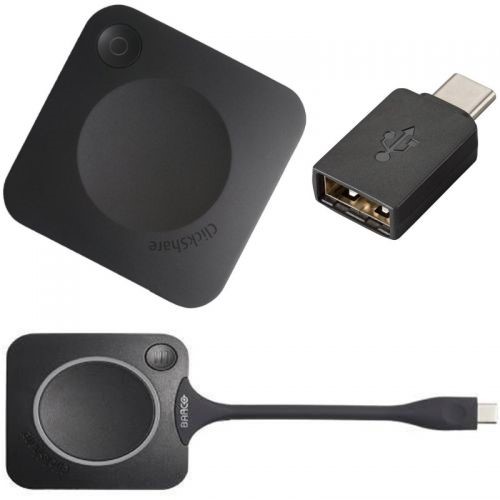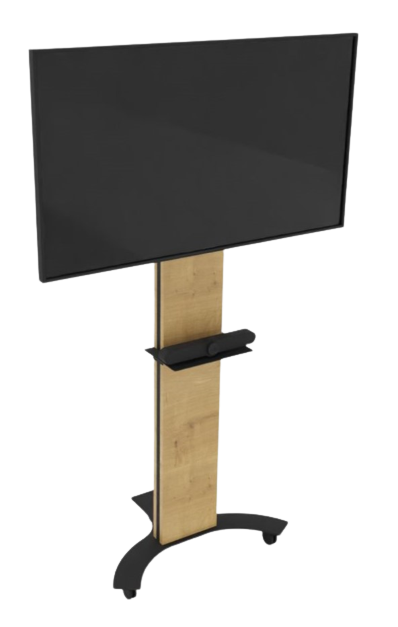Last update: 04/14/25
To get the most out of your collaboration efforts and to maximise the effectiveness of your meetings, quality audiovisual equipment is essential.
In this article, you will find a list of essential AV equipment for your meeting rooms, as well as the ‘nice-to-haves’ and some tips for optimal integration of this equipment.
The focal point of any conference room is its screen. For meetings with remote participants, it is a key piece. But even when everyone in the meeting is in person, it is on the room screen that they will be able to share their content.
With a single screen, you will probably have a picture-in-picture feature. This means that you can choose to see the shared content or the other participants in the video call on the large screen. Content is often chosen for the wide view, as it usually drives the conversation of the meeting. What is not in the wide view is displayed in a small square at the bottom of the screen, which can reduce one of the main benefits of video conferencing: seeing remote participants.
The dual display offers a solution to the picture-in-picture problem. People in the meeting see both the content being presented and the remote participants, each on their own full screen. Instead of choosing between content and people, you can see both clearly. This promotes collaboration by allowing participants to see nuances such as facial expressions during the presentation.
Speakers are an important issue in any collaborative space: everyone must be able to hear the presenter effortlessly. Wall-mounted speakers, such as a home surround sound system, can provide uniform volume throughout the space. Alternatively, ceiling-mounted speakers can provide the sound dispersion necessary for quality audio broadcasting. In both cases, suitable speakers eliminate the need to turn up the volume to uncomfortable levels, which usually occurs when sound is delivered to a large area.
Microphones can be installed in the table itself, with audio cabling running through integrated cable trays to the floor. The microphones can be largely invisible, but they should also be omnidirectional and positioned at all pickup intervals for optimum clarity.
Unfortunately, some Wi-Fi signals are erratic or too weak to handle large amounts of video data. Your meeting room AV solution should include Wi-Fi capabilities but also Ethernet so that you have a secure wired connection when needed.
It is estimated that around 65% of people are visual learners. An interactive whiteboard (or digital board) can therefore be a valuable tool to add to your conference room equipment. Interactive displays allow participants to write directly on the board in different colours, annotating on web pages or documents… Video conferencing platforms such as Zoom allow users to use a whiteboard during the call and share it with other participants in real time or once the meeting is over.
There’s nothing more frustrating and time-consuming than fiddling with cables and wires at the start of a meeting. Plug & Play technology makes it quick and easy to connect to your collaboration tools.
For wireless connection to a large screen, products like Barco’s Clickshare are easy to use:

Or if you need to quickly connect to a camera and audio system for a video call, the Logitech Rally Bar will do the trick:

Having a system that can be easily moved from one location to another can be useful. This means that instead of equipping all your meeting rooms, you can buy fewer devices and move them around as needed.

There are several aspects to consider in a meeting room project: the layout of my room, its furniture and the audiovisual equipment. Does this mean that you will have to deal with three people? The answer is up to you. You may well choose a fitter, a furniture manufacturer and a technology integrator, or a global integrator who will be able to offer you a complete, tailor-made response to your needs.
If you wish to have furniture and collaboration tools handled by the same service provider, you should choose a global integrator. This has several advantages:
It is important to choose your audiovisual equipment according to your space and vice versa. An integrator who masters both aspects will be able to enlighten you on the basics of a high-performance collaborative meeting room:
What could be more insecure and inhospitable than to be in a workspace with cables sticking out everywhere? In addition to the impaired visual perception, safety is no longer fully guaranteed in such a place.
As you can see, furniture and audiovisual equipment are closely linked in a collaborative meeting room project. We therefore strongly encourage you to treat these two parts together.